Main menu
Common skin conditions

NEWS
Join DermNet PRO
Read more
Quick links
Actinic cheilitis — extra information
Lesions (cancerous) Lesions (benign)
Actinic cheilitis
Author: Dr Mark Duffill, Dermatologist, Hamilton, New Zealand, 2008. Updated by Dr Amanda Oakley, Dermatologist, Hamilton, New Zealand, December 2015.
Introduction Demographics Causes Clinical features Complications Diagnosis Treatment Prevention Outlook
What is actinic cheilitis?
Actinic cheilitis is the lip form of actinic keratosis due to chronic sun exposure. It is also called actinic cheilosis, solar cheilitis, and sometimes, actinic cheilitis with histological atypia.
Actinic cheilitis also describes lip involvement in actinic prurigo, a rare form of photosensitivity.
Who gets actinic cheilitis?
Actinic cheilitis mainly affects adults with fair skin who live in tropical or subtropical areas, especially outdoor workers. They often recall having sunburned lips in earlier years. They may also have actinic keratoses and/or solar lentigines on other sun-exposed sites of the scalp, ears, face, and hands.
Actinic cheilitis is three times more common in males than in females.
What causes actinic cheilitis?
Actinic cheilitis results from chronic exposure of the lower lip to solar ultraviolet radiation. It is more vulnerable than surrounding skin because mucosal epithelium is thinner and less pigmented than the epidermis.
What are the clinical features of actinic cheilitis?
Actinic cheilitis most commonly affects the lower lip (90%), presenting as:
- Dryness
- Thinned, fragile, skin
- Thickened, scaly papules and plaques.
Other clinical features of actinic cheilitis may include:
- Swelling
- Redness
- Soreness
- Fissuring, focal ulceration and crusting
- Loss of demarcation between the vermilion border of the lip and its adjacent skin
- White thickened patches (leukokeratosis)
- Discoloured skin with pale or yellow areas
- Prominent folds and lip lines
- Difficulty applying lipstick, which tends to “bleed” into the surrounding lines.
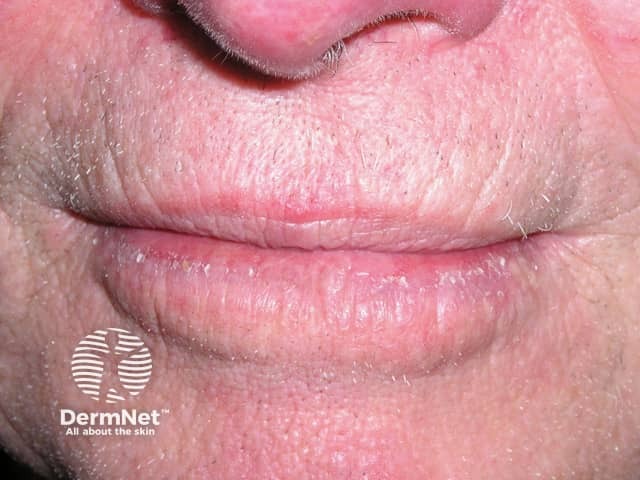
Actinic cheilitis
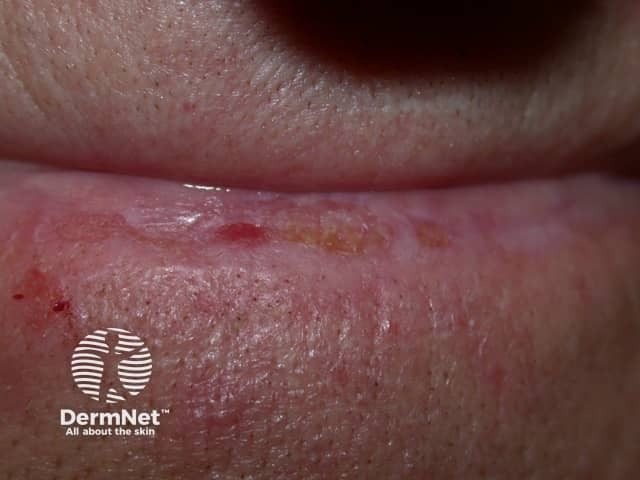
Actinic cheilitis
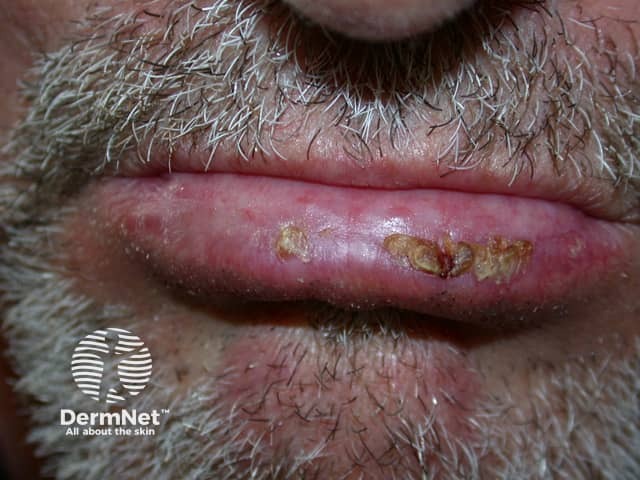
Actinic cheilitis
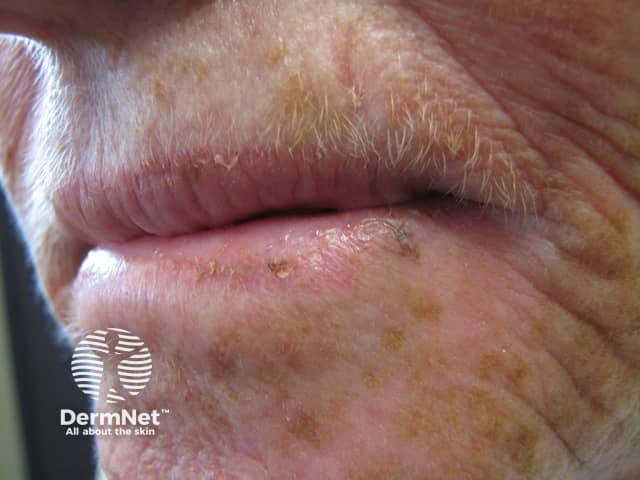
Actinic cheilitis
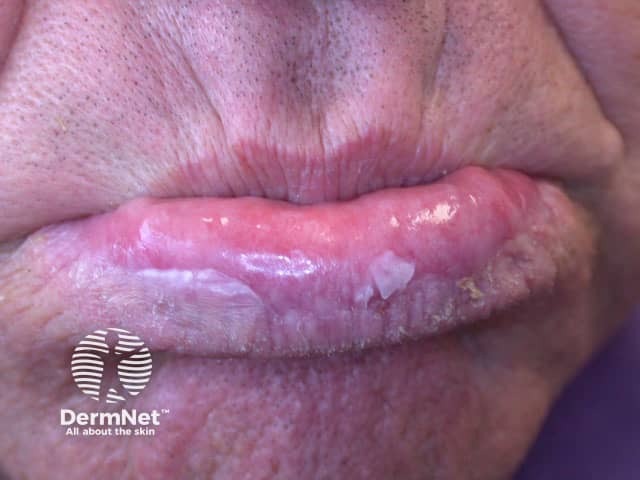
Actinic cheilitis

Actinic cheilitis
What are the complications of actinic cheilitis?
Actinic cheilitis is a pre-malignant condition. It predisposes to:
- Intraepidermal carcinoma (Bowen disease or squamous cell carcinoma in situ)
- Invasive squamous cell carcinoma.
Cancer of the lip is more common in smokers than in non-smokers. Other factors include oncogenic human papillomavirus (wart virus), alcohol abuse, and immunosuppression.
Invasive squamous cell carcinoma should be suspected if the lip is focally tender, or a persistent ulcer or enlarging nodule develops.
How is actinic cheilitis diagnosed?
Actinic cheilitis is usually diagnosed clinically. A skin biopsy may be taken if skin cancer or an inflammatory cause of cheilitis is suspected.
The histological features of actinic cheilitis are variable thickening or atrophy of the lip, partial thickness epidermal dysplasia, solar elastosis, and inflammation in the dermis.
What is the treatment for actinic cheilitis?
General measures
Smoking cessation and lifelong, year-round, daily sun protection are essential.
- Limit sun exposure
- Wear a hat with a wide brim
- Apply sunscreen-containing lip balm frequently
Men can consider growing a moustache.
Specific measures
Topical therapies for actinic cheilitis are unapproved. They include:
Physical treatments for actinic cheilitis include:
- Cryotherapy
- Electrocautery
- Vermilionectomy (surgical removal of the external lip)
- Laser ablation, eg carbon dioxide laser.
Vermilionectomy and carbon dioxide laser treatment have the most favourable outcome, with fewer recurrences compared to chemical peel and photodynamic therapy.
How can actinic cheilitis be prevented?
Actinic cheilitis can be prevented by protecting the lips from sun exposure. In smokers, the risk of cancer can be reduced by smoking cessation.
What is the outlook for actinic cheilitis?
Actinic cheilitis can improve with effective sun protection and treatment. Continued sun exposure and lack of treatment increase the risk of squamous cell carcinoma, which is potentially life threatening.
Bibliography
- Cavalcante AS, Anbinder AL, Carvalho YR. Actinic cheilitis: clinical and histological features. J Oral Maxillofac Surg. 2008;66(3):498–503. doi:10.1016/j.joms.2006.09.016. Medline.
- Lai M, Pampena R, Cornacchia L, Pellacani G, Peris K, Longo C. Treatments of actinic cheilitis: a systematic review of the literature. J Am Acad Dermatol. 2020;83(3):876–87. doi:10.1016/j.jaad.2019.07.106. PubMed
- Trager MH, Farmer K, Ulrich C, et al. Actinic cheilitis: a systematic review of treatment options. J Eur Acad Dermatol Venereol. 2021;35(4):815–23. doi:10.1111/jdv.16995. PubMed
- Vieira RA, Minicucci EM, Marques ME, Marques SA. Actinic cheilitis and squamous cell carcinoma of the lip: clinical, histopathological and immunogenetic aspects. An Bras Dermatol. 2012;87(1):105–14. doi:10.1590/s0365-05962012000100013. Available from: http://www.scielo.br/scielo.php?script=sci_arttext&pid=S0365-05962012000100013&lng=en. http://dx.doi.org/10.1590/S0365-05962012000100013.
On DermNet
